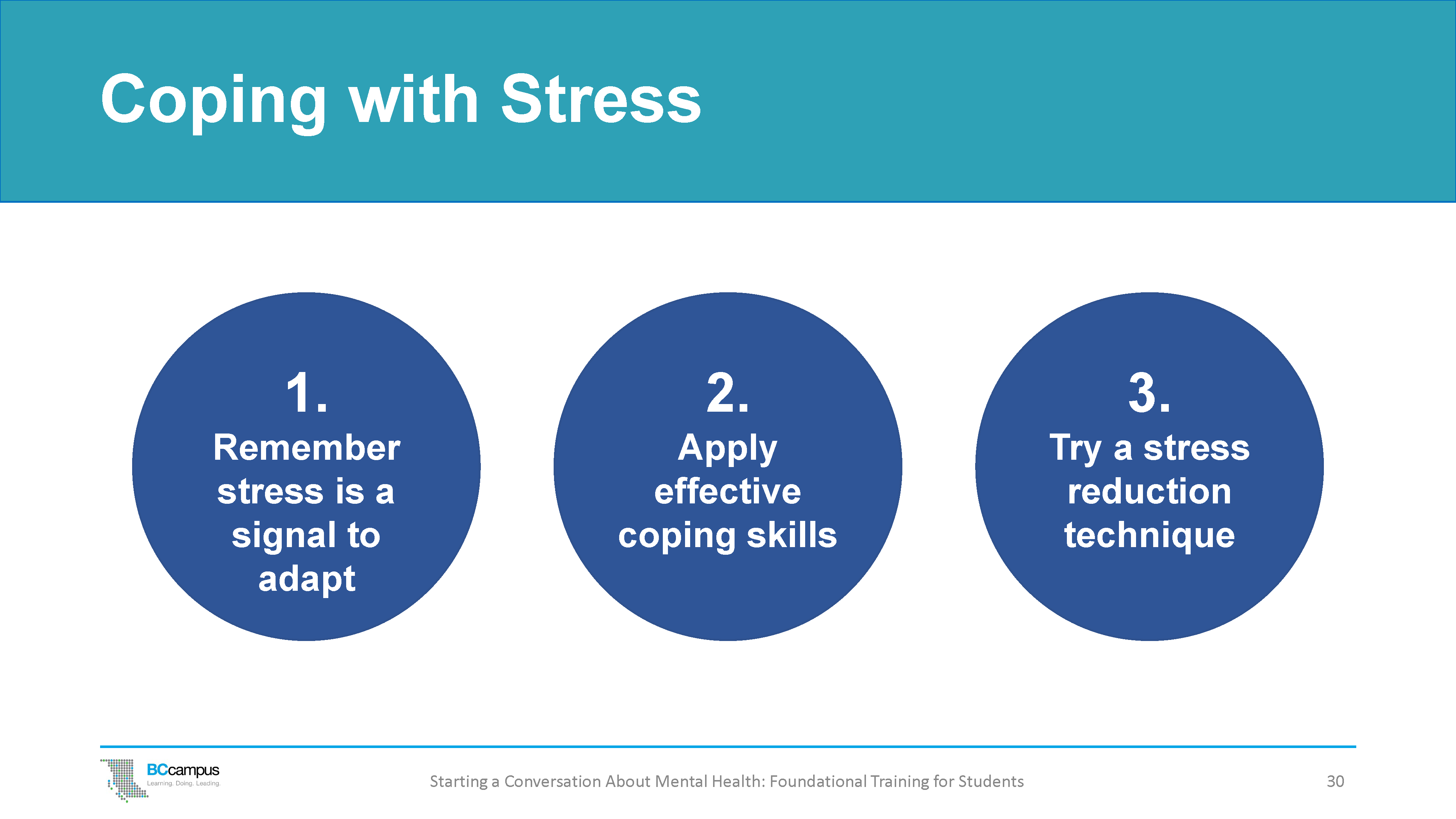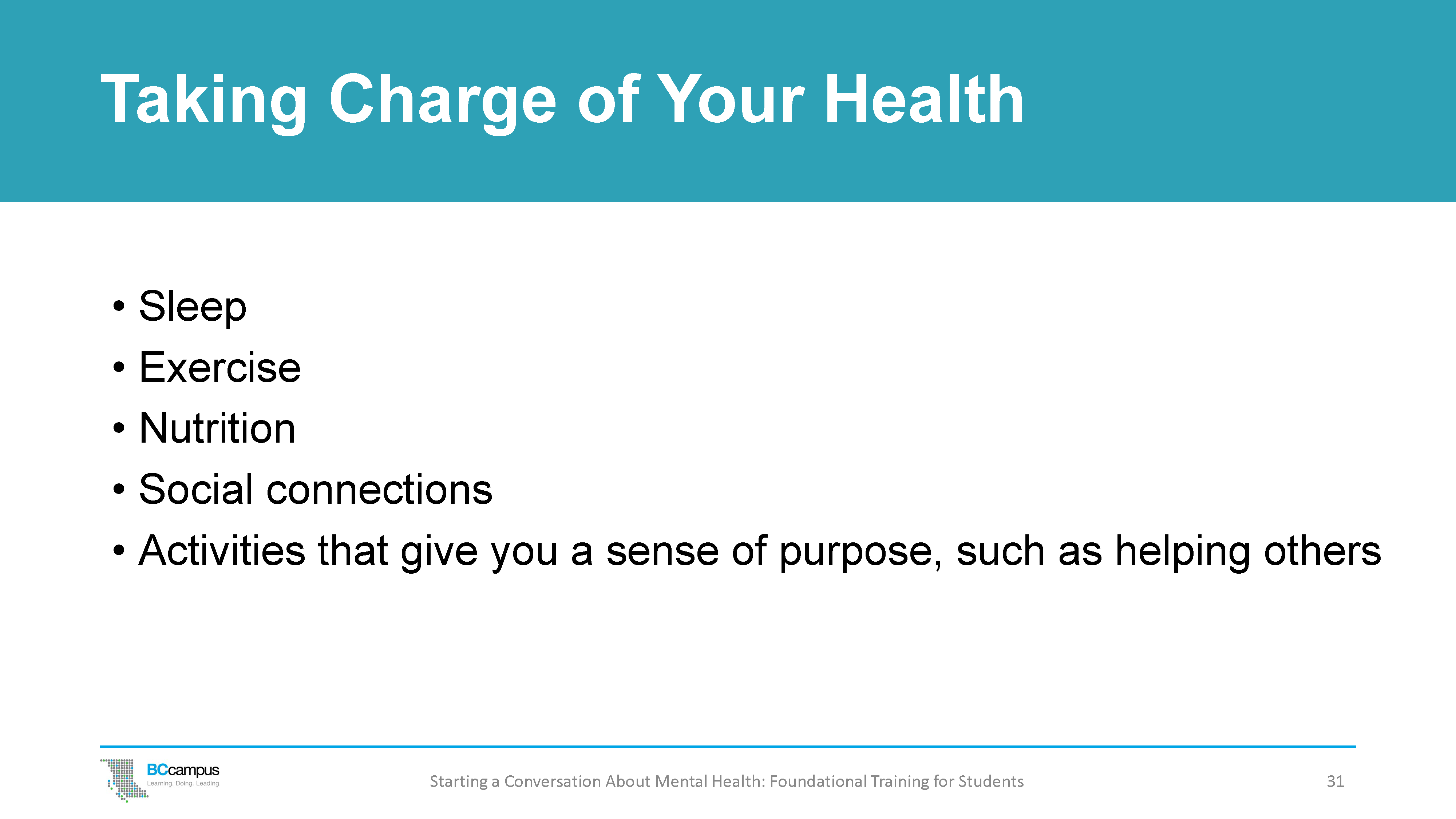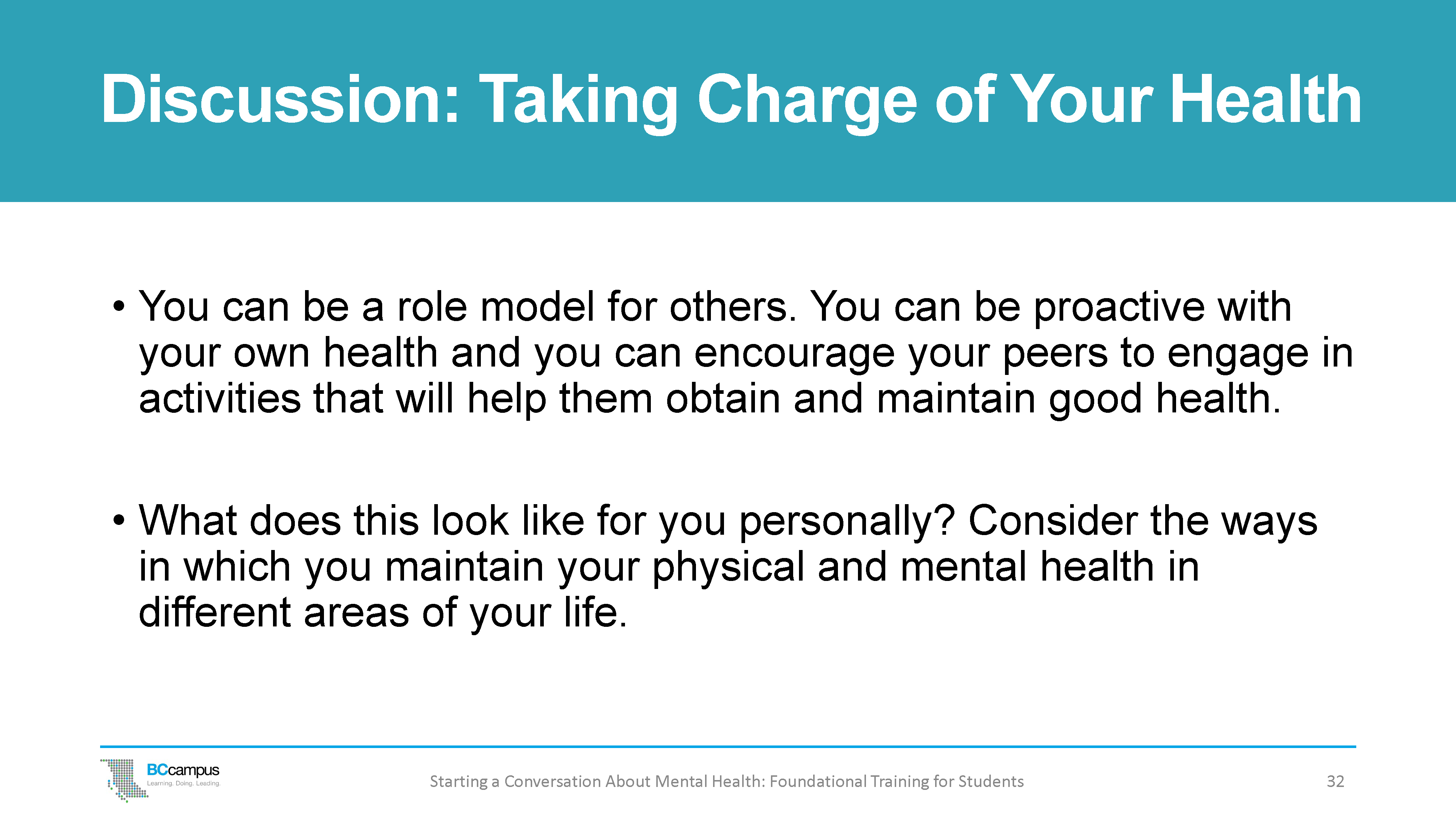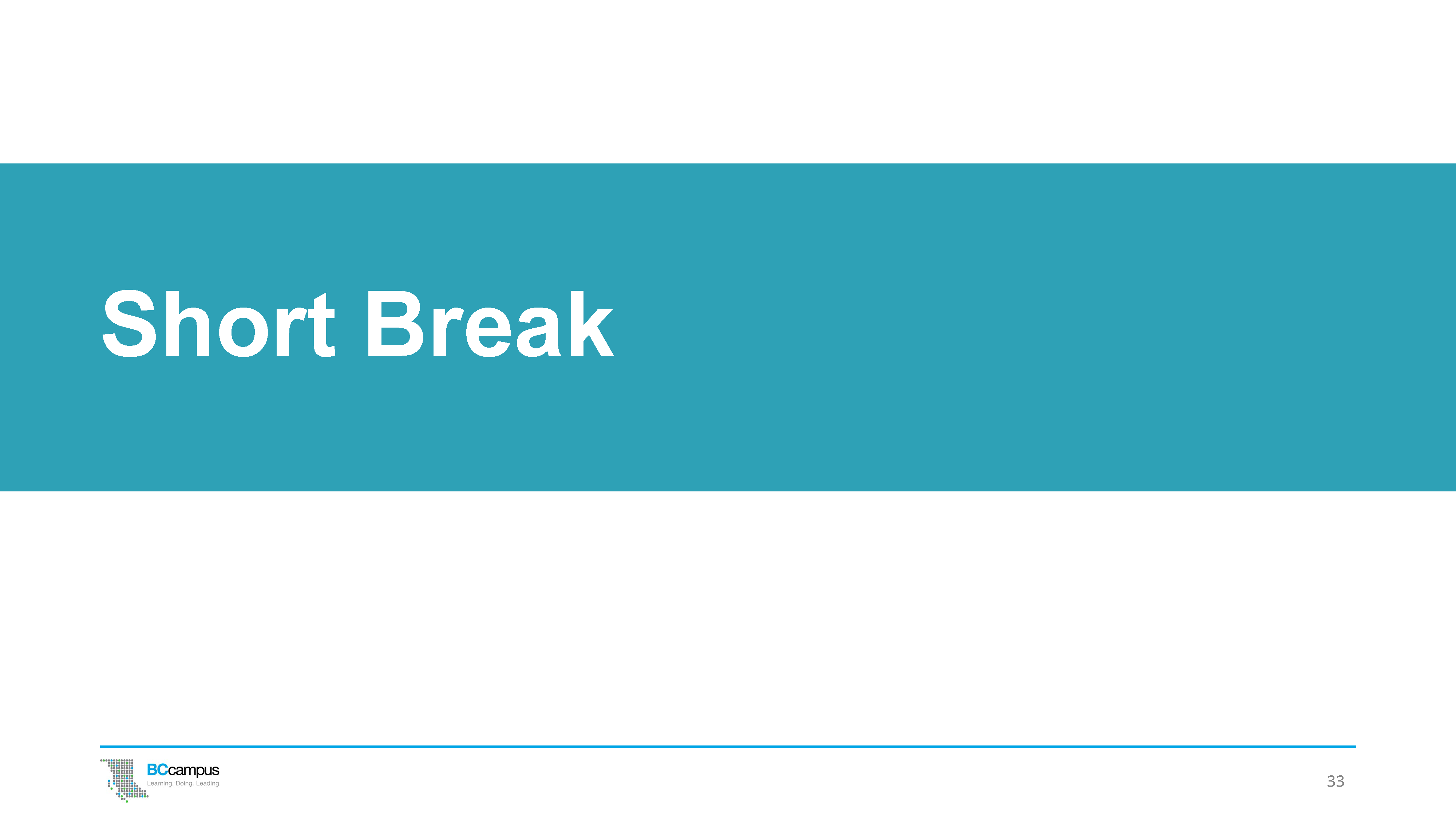6. What To Do When We’re Stressed
There are things we can do to help us cope with stress. This section looks at key steps we can take to manage stress.
These slides are available for use with this section of the presentation. For information about downloading the slide deck, see the Introduction.
How can we help ourselves and others who are experiencing the stress response?
The Wellness Wheel helps us to identify what might be out of balance and causing us stress. There are also three important steps to remember when we want to make stress work for us.

Three Steps for Coping with Stress
You may want to share Handout 2: Coping Strategies with participants now.
1. Reframe the Stress Response
- Think of it as a signal for your body and brain to adapt to changes in your environment and prepare for a challenge. The stress response is your body’s way of letting you know that you need to adapt to changes in your environment. Learning how to effectively manage the stress response can help you build resilience.
- Reframe the stress response: “My body and brain are getting me ready to face this challenge. I am getting ready for an important task.”
- Identify the source of your stress response: “Why am I feeling this stress response?” (Refer to the Wellness Wheel to identify what may be out of balance.)
- Make a plan: Use past experiences or brainstorm new ways to approach a difficult situation. Discuss the situation with friends and family and ask for help, if needed.
- Apply your solutions to the problem.
For example:
- If your studies are the source of your stress response, access support and resources to develop your learning strategies.
- Feel like you have too much to do and don’t know where to start? Consider how you are managing your time.
2. Model or Apply Effective Coping Skills
Before, during, or after a stressful experience, effective coping strategies include:
- Considering solutions to the problem
- Connecting with your social support
- Practising healthy habits for sleeping, eating, and physical activity
There are also things you can do on a daily basis to help you feel ready to face the various challenges in school, work, and life. For example:
Take care of the basics:
- Focus on getting enough sleep.
- Fuel up on healthy foods.
- Exercise – walk, stretch, go to the gym, dance, or do yoga.
Make time to unwind:
- Create art or write – draw, journal, write poetry or a compassionate letter to yourself.
- Curl up on a couch with a book.
- Enjoy a hot beverage with a friend or family member.
- Listen to comforting music.
- Spend time on your favourite course.
- Remind yourself of your strengths. (I’m good at …)
- Garden – grow something, bring flowers into your room.
- Laugh – read a funny book, watch a comedy, visit a local garden.
- Try muscle relaxation exercises.
- Find a quiet, safe space, such as a garden, park, or library, where you can relax.
Stay connected or get involved:
- Call friends or family when you need to talk.
- Build a support network – contact old friends or join a club.
- Have fun and meet new people by volunteering in your community.
- Connect with individuals with similar experiences and interests.
Refer to the Wellness Wheel for more ideas.
3. Try Reducing Your Stress Response in the Moment
For example, try this box breathing technique. It can help bring your heart rate back to normal, so you feel a little more relaxed. Here’s how you do it:
If possible, sit and close your eyes. If not, just focus on your breathing.
- Step 1: Inhale (preferably through your nose) for a count of four.
- Step 2: Hold your breath for a count of four. You’re not trying to deprive yourself of air; you’re just giving the air a few seconds to fill your lungs.
- Step 3: Exhale slowly through your mouth for a count of four.
- Step 4: Pause for a count of four before breathing again.
Repeat this process as many times as you can. Even 30 seconds of deep breathing will help you feel more relaxed and in control.
Practising mindfulness can also reduce the stress response. Apps such as Headspace, Calm, and Insight Timer provide guided or unguided mindfulness options.
Global Events and Mental Health
Many global events have been shown to have an impact on mental health.
For example, most people experienced increased levels of stress and anxiety from the COVID-19 global pandemic. It activated the stress response for an extended and undefined amount of time, and as we navigate the aftermath of the pandemic, we are discovering its full impact on mental health. Many people experienced stress from the prolonged fear, isolation, disruption, and uncertainty that the pandemic created, and many will continue to feel these impacts.
COVID-19 also brought to light many inequities that exist within society, and Black Lives Matter amplified awareness of these problems. Many people – both Indigenous and non-Indigenous – were also strongly affected by the discovery of the unmarked graves at Indian residential schools across the country. These discoveries have retraumatized many Indigenous people, and forced many non-Indigenous people to reckon with the violent beginnings of our country and its colonial past and present.
Climate change and related disasters such as fires, floods, droughts, and extreme weather can also cause elevated levels of anxiety, stress, depression, grief, and post-traumatic stress disorders. The trauma and losses from a disaster, such as losing a home or job and being disconnected from one’s neighbourhood and community, can contribute to depression and anxiety.[1]
Things to keep in mind about mental health and global events:
- It is normal to feel an increased sense of stress as a result of these global events, which have caused great upheaval. During a pandemic or after a natural disaster, our regular coping strategies, such as going to a gym class, singing in a choir, playing team sports, or visiting friends and family, are not as effective or may be unavailable because of public health guidelines.
- This doesn’t mean we should give up. In fact, during times of upheaval, there is even more need to consider your mental health and create a plan for activating effective coping and soothing strategies.

Taking Charge of Your Health
Another important aspect of dealing effectively with stress is taking care of your overall health so that you have energy and resources to adapt to the challenge you are facing.
Research shows that strategies for attaining and maintaining physical and mental health are the same:
- Sleep, exercise, nutrition, social connections, and activities that give you a sense of purpose, such as helping others, have all been shown consistently to positively impact mental and physical health.
- These five strategies consistently show positive impacts. You likely do many other things to maintain and enhance your health.
Maintaining your physical and mental health is a lifelong process:[2]
- Every time your life situation changes – where you live, where you work, who you spend time with, how you spend your time – your health behaviours can undergo a shift.
- It’s important to reflect on how and whether you are engaging in activities to maintain these five areas of your life. For example, maybe you don’t have time to exercise all the time, but when you are feeling like you need a break from studying for your midterms, you can go and be active to feel at your best.
- More importantly, what physical and mental health looks like for you – given your likes/dislikes, unique life situation, physical ability, and so on – may be different from other people you know. What works for one person – say, swimming twice a week at an aquatic centre – may not work for someone else.

ACTIVITY: Discussion on Taking Care of Your Health
Have participants break out into small groups to discuss the following:
- You can be a role model for other students. You can be proactive with your own health and you can encourage your peers to engage in activities that will help them attain and maintain good health.
- What does this look like for you as a student? Consider the ways in which you maintain your physical and mental health in terms of these areas of your life.
Short Break
If you would like to give participants a short break, this is a good time to do it. It will give them a chance to get up and stretch and reflect on all they’ve learned about mental health and taking care of themselves before moving on to the next sections, which focus on how students can help other students who are struggling with stress or experiencing mental distress.

Text Attributions
- This chapter was adapted from Mental Health Literacy for Student Leaders © UBC Student Health and Wellbeing staff (CC BY 4.0 License).
- “Global Events and Mental Health” by Barbara Johnston is licensed under a CC BY 4.0 License.
- U.S. Global Change Research Program. (2016). The Impacts of Climate Change on Human Health in the United States: A Scientific Assessment. https://health2016.globalchange.gov/ ↵
- Adapted from Ohrnberger, J. Fichera E., & Sutton, M. (2017). The relationship between physical and mental health: A mediation analysis. Social Science and Medicine, 195. https://doi.org/10.1016/j.socscimed.2017.11.008 (CC BY 4.0 License) ↵

